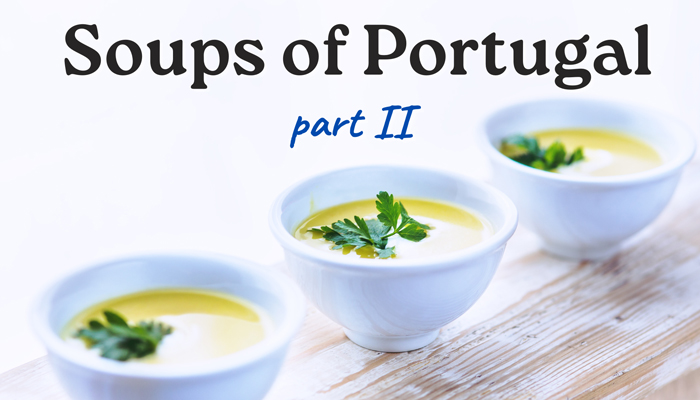We continue our “warm and tasty” theme about Portuguese food. In this article you will learn more about the country’s less popular soups, but no less interesting and famous among locals. Moreover, let’s look at Portuguese vocabulary on this topic.
Sopa de Entulho (Debris or Rubble Soup)
It is a regional and lesser-known Portuguese dish that originates from the Beira region, specifically the town of Almeida. Traditionally, it is made by simmering a variety of ingredients, including: feijão(bean), batata(potato), cenoura(carrot), repolho(cabbage), cebola(onion), carne de porco curada(cured pork)
These ingredients are often cooked slowly to allow the flavors to meld together, resulting in a delicious and comforting dish. It is known for its rustic and hearty nature, making it a popular choice during the colder months. It is often enjoyed as a main course, accompanied by pão-duro(crusty bread) to soak up the flavorful broth.
Canja de Galinha (Chicken Soup)
It is a beloved and comforting dish that holds a special place in Portuguese cuisine. It is often enjoyed during times of illness or as a warming meal on a chilly day. It is known for its simplicity and soothing qualities, making it a popular choice for both nourishment and comfort.
The key ingredient is frango(chicken), which is simmered with water to create a flavorful broth. The chicken is often cooked with bone-in for added richness and depth of flavor. Aromatic ingredients such as alho(garlic), onions, carrots, and sometimes arroz (rice) are added.
One of its defining characteristics is its texture. The rice, if included, becomes tender and adds a satisfying thickness. The result is a creamy and hearty dish with a delicate balance of flavors.
It is often served garnished with ervas frescas(fresh herbs), such as parsley or coriander, which add a burst of freshness. It is also common to squeeze a few drops of sumo de limão(lemon juice) just before serving to enhance its taste.
It is a comforting meal or a remedy for illness. It provides nourishment for the body and soul. Its simplicity and homely qualities reflect the essence of Portuguese cuisine and the importance of sharing meals with loved ones.
Sopa de Castanhas (Chestnut Soup)
As the name suggests, it features the rich and earthy flavor of castanhas(chestnuts), a popular ingredient in Portuguese cuisine, especially during the autumn and winter months.
To prepare it, fresh or dried chestnuts are typically used. They are simmered in a flavorful broth along with vegetables such as onions, salsão(celery), and carrots. It may also include potatoes, alho-poró(leeks), and aromatic herbs like folhas de louro(bay leaves) and tomilho(thyme), which enhance the overall taste and aroma.
Once the ingredients have cooked and melded together, the soup is often pureed or partially mashed, creating a smooth and creamy texture. This step brings out the natural sweetness and nuttiness of the chestnuts while adding richness to the dish.
It is often served with crusty bread for dipping and drizzled with azeite(olive oil) for extra flavor. Its warmth and comforting qualities make it a delightful choice for a nourishing and satisfying meal. Sopa de Castanhas is a celebration of the harvest and showcases the country’s strong connections to its natural resources and seasonal produce.
Sopa de Pobre (Poor Man’s Soup)
It typically consists of a basic caldo de legumes(vegetable broth) with added usual ingredients: vegetables and sometimes beans. It’s often seasoned with herbs like salsinha(parsley), bay leaves, and sometimes a splash of olive oil to enhance the taste. It is a dish that demonstrates how a few basic elements can be transformed into a flavorsome and fulfilling meal.
Today, Sopa de Pobre remains a popular dish in Portugal, serving as a reminder of the country’s humble culinary roots and its commitment to making delicious and satisfying food accessible to all, regardless of socioeconomic status.
Sopa de Agrião (Watercress Soup)
At its core, Sopa de Agrião features fresh folhas de agrião(watercress leaves) as the star ingredient. The peppery and slightly bitter notes of watercress add depth to the flavor profile. Moreover, watercress is a nutritional powerhouse. It’s packed with vitamins A, C, and K, along with essential minerals like iron and calcium. This combination offers antioxidant properties, supports bone health, and boosts the immune system.
Some recipes might incorporate additional vegetables or even a hint of spice, while others stay true to the simplicity of the original.
Sopa de Nabos(Turnip soup)
At the heart of it are nabos(turnips), a root vegetable known for its earthy and slightly sweet taste. Turnips provide vitamin C, fiber and minerals. The preparation involves sautéing onions and garlic in olive oil, adding diced turnips and potatoes, and simmering the ingredients until they meld into a harmonious blend. Some variations may include the use of greens, enhancing both the visual appeal and nutritional content of the dish.
Sopa de Lentilhas (Lentil soup)
The star of the show, lentils, takes center stage, bringing a protein-rich and fiber-packed element to the table. Is usually complemented by onions, carrots, garlic, and sometimes chouriço(chorizo) or other meats. It not only satisfies the taste buds but also contributes to a well-rounded and health-conscious diet.
Its versatility allows for regional variations and personal preferences. Some may choose to add leafy greens or tomates(tomatoes), while others might opt for a spicier kick with additional temperos (seasonings).
Conslusion
As you may have noticed, all soups consist of approximately the same ingredients, so don’t be surprised if you think they taste the same. It’s all in the details!
Portugal is a country where everyone loves to eat a lot and deliciously. So don’t be surprised that we talk about this a lot. Food is a part of our daily life. If you combine this necessity and the variety of Portuguese cuisine, you get a great gastronomic tour!
